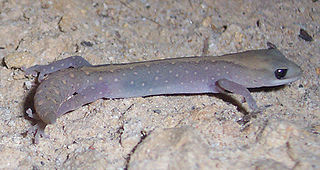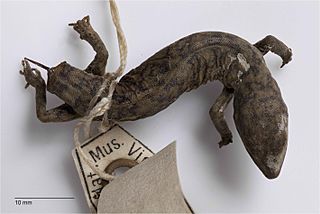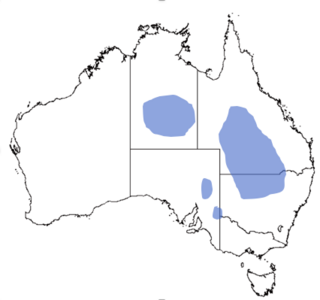
Gehyra is a genus of geckos in the family Gekkonidae that resemble house geckos. They are known as web-toed geckos or dtellas, and are commonly mistaken for house geckos in parts of Asia.

Crenadactylus ocellatus, also known as the southwestern clawless gecko or western clawless gecko, is the smallest species of nocturnal Gekkonidae (gecko) found in Australia.

Diplodactylus is a genus of geckos of the family Diplodactylidae from Australia. They are sometimes called stone geckos or fat-tailed geckos. Member species are morphologically similar but genetically distinct.

Oedura is a genus of medium to large geckos, lizards in the family Diplodactylidae. The genus is endemic to Australia. Species in the genus are referred to by the common name velvet geckos.

Underwoodisaurus is a small genus of Australian geckos, commonly known with the species Uvidicolus sphyrurus as thick-tailed geckos. The species Underwoodisaurus milii is often called the thick-tailed gecko.

Crenadactylus, the clawless geckos, are named for their distinguishing feature, the absence of terminal claws on the digits. They are the only Australian members of Gekkonidae to lack claws, the endemic genus is also the smallest in size.
Arnold G. Kluge is professor emeritus of zoology and curator emeritus of amphibians and reptiles at the University of Michigan, Museum of Zoology. Kluge authored over 140 journal articles. He served as past president of the Willi Hennig Society and as editor-in-chief of its journal Cladistics. He served at the University of Michigan from 1965 until his retirement in 2003.
Lucasium byrnei, commonly known as the gibber gecko or Byrne's gecko, is a species of small, nocturnal gecko, a lizard in the family Diplodactylidae. The species is endemic to Australia.
Lucasium stenodactylum, also known as the crowned gecko or pale-snouted ground gecko, is a species of gecko from Australia.
The Kimberley death adder is a species of venomous snake in the family Elapidae native to northwestern Australia.

The variable fat-tailed gecko or burrow-plug gecko is a Diplodactylid gecko endemic to central and arid inland areas of Australia. Widespread across the continent, the variable fat-tailed is most commonly found in sandy desert habitats dominated by Spinifex grasses. They have also been bred in captivity by zoos and as pets.

Oedura cincta, or inland marbled velvet gecko, is an Australian species of gecko.
The Mount Augustus spiny-tailed gecko, also known commonly as the Mount Augustus striped gecko, is a species of lizard in the family Diplodactylidae. The species is endemic to Australia.

Pygopodoidea is a gecko superfamily and the only taxon in the gekkotan subclade Pygopodomorpha. The clade includes three Australasian families: Diplodactylidae, Carphodactylidae, and Pygopodidae. Traditional gekkotan systematics had considered Diplodactylidae and Carphodactylidae as subfamilies of the family Gekkonidae, but recent molecular work have placed Pygopodidae within Gekkonidae making it paraphyletic. These analyses have shown support of Pygopodidae and Carphodactylidae being sister taxa, with Diplodactylidae occupying a basal position in Pygopodoidea.
The northern clawless gecko is a species of gecko endemic to Western Australia and Northern Territory in Australia.
Crenadactylus occidentalis, also called the western clawless gecko, is a species of gecko endemic to the western coast of Australia.
Crenadactylus pilbarensis is a species of gecko found in the Pilbara region of Australia. They resemble other species of the genus Crenadactylus, tiny clawless Australian geckos found across a large area of the continent, but has persisted as an ancient lineage in a region of the northwest.
The Southwest Kimberley clawless gecko is a species of gecko endemic to Western Australia in Australia.
The Cape Range clawless gecko is a species of gecko endemic to Western Australia in Australia.
Lerista frosti is a smaller lizard species found in highlands of central Australia.








